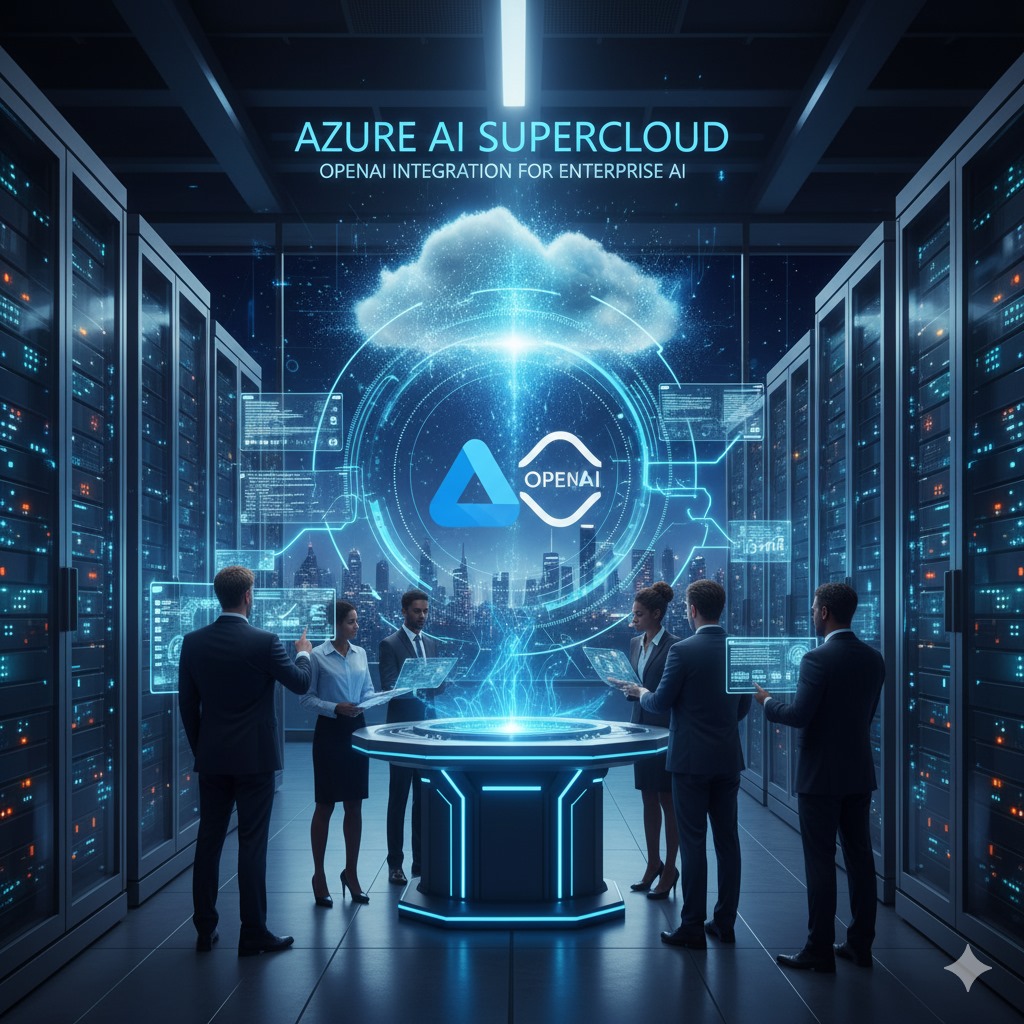Introduction
Microsoft has expanded Azure AI Supercloud with deeper integration of OpenAI models, delivering enterprises integrated model access, governance controls, and scaled AI infrastructure via Azure [1][2]. For business leaders planning AI transformation, this expansion changes how organizations procure, govern, and operate foundation models in production. This article explains the business value, technical implications, concrete use cases, and pragmatic steps to adopt Azure AI Supercloud integrated with OpenAI while outlining risks and limitations.
What the expansion delivers
Integrated model access and lifecycle management
The core announcement centers on integrated access to OpenAI models through Azure, enabling enterprises to call, manage, and govern foundation models from within their Azure environments [1][2]. This simplifies procurement and operational workflows by consolidating model access into existing cloud accounts and identity systems.
Governance, safety and compliance tooling
Microsoft emphasizes enterprise-grade governance: built-in policy, monitoring, and controls to ensure responsible use of models in regulated contexts [1]. By embedding governance into the platform, organizations can better monitor usage, enforce guardrails, and retain audit trails required for compliance.
Scale, performance, and integration with Azure infrastructure
Azure AI Supercloud couples model access with scalable compute, networking and data services, enabling enterprises to run inference and model-driven workloads at scale using Azure’s data and infrastructure stack [1][2]. This alignment reduces integration friction and supports predictable performance for production applications.
Business value and strategic impact
Faster time-to-value
Consolidated model access and governance reduces the time required to move from pilot to production. Teams no longer need to build bespoke connectors between cloud/accounts and third-party models; they can reuse enterprise identity, logging, and data pipelines already in Azure [1].
Operational risk reduction
Embedding governance, auditing, and policy tools into the platform reduces operational and compliance risk, particularly for finance, healthcare, and regulated industries that require traceability for automated decisions [1].
Cost and vendor management benefits
Centralizing OpenAI model access inside Azure lets finance and procurement teams manage usage and billing within existing cloud contracts and reporting frameworks, simplifying cost control and vendor oversight [2].
Real-world examples and applications
Customer service automation
Enterprises can leverage integrated OpenAI models in Azure to power conversational agents that access internal CRM and knowledge bases via Azure services. Because the model calls are made inside the customer’s Azure tenancy, enterprises maintain tighter control over data flows and logging for incident analysis and compliance [1].
Sales enablement and personalized outreach
Sales teams can use model-driven content generation combined with Azure-hosted customer data to create personalized messaging at scale while capturing model outputs and prompts for governance and quality assurance [1][2].
R&D, code generation, and developer productivity
Development teams can integrate model APIs into CI/CD pipelines and internal developer tools hosted on Azure, accelerating prototyping and generating boilerplate code while maintaining auditability through platform logs [1].
Actionable adoption roadmap for business leaders
Below is a pragmatic sequence of steps to adopt Azure AI Supercloud with OpenAI integration in your enterprise.
1. Establish executive sponsorship and strategic goals
- Define clear business objectives (e.g., reduce support costs by X%, accelerate time-to-decision, increase developer productivity).
- Assign executive sponsors and cross-functional owners for data, security, legal, and product.
2. Inventory data, workloads and regulatory constraints
- Map sensitive data flows, data residency requirements, and compliance obligations.
- Classify workloads suitable for model augmentation vs. those requiring stricter control.
3. Pilot inside a governed Azure tenancy
- Run a limited-scope pilot using Azure AI Supercloud integration to validate end-to-end flows: data access, model inference, logging, and monitoring [1].
- Use platform governance features to capture usage metrics and establish baseline policies.
4. Implement guardrails and monitoring
- Enforce role-based access, input/output filtering, and query logging to build an auditable trail.
- Establish performance and safety monitoring to detect drift, hallucination patterns, or unexpected usage spikes.
5. Scale with cost controls and cross-team onboarding
- Integrate usage reporting into cloud cost dashboards and set budgets/alerts for model access [2].
- Provide templates, SDKs, and governance playbooks to product teams to accelerate safe adoption.
Technical integration considerations
Identity, access and networking
Because model calls are brought into Azure’s environment, align model access with Azure Active Directory and VNet configurations to control which services and applications can call models. This reduces attack surface and simplifies access reviews [1].
Data handling patterns
Design data flows that minimize sensitive data exposure: anonymize or tokenise PII before sending prompts, and store model outputs in controlled storage with encryption and retention policies managed through Azure services [1].
Observability and auditing
Use centralized logging and monitoring to capture prompt, response metadata, latency, and cost. These telemetry streams should feed into security information and event management (SIEM) and governance dashboards to support investigations and compliance reporting [1].
Risks, limitations, and mitigation
Regulatory and compliance risk
Even with integrated governance, organizations remain responsible for outputs used in regulated decision-making. Enforce human-in-the-loop checks and maintain auditable records of model inputs and outputs when used for critical decisions [1].
Model behavior and reliability
Foundation models can produce incorrect or biased outputs. Implement validation pipelines, testing datasets, and monitoring to detect and remediate degradation or undesirable behavior before automating decisions at scale [1].
Vendor lock-in and portability
Centralizing on a cloud-provider integrated model pathway eases operations but can create tighter coupling between cloud services and model providers. Maintain abstraction layers and exportable logs and artifacts to preserve portability options if needed [2].
Cost and procurement considerations
Integrating OpenAI models through Azure consolidates billing and vendor relationships, allowing finance teams to govern costs within existing cloud contracts [2]. Establish chargeback models, tagging, and budgets early to prevent runaway consumption and ensure predictable TCO as usage scales.
Practical checklist for the first 90 days
- Define KPIs for pilot (accuracy, response time, cost per transaction).
- Set up an Azure tenant with identity, VNet, and logging configured for model access [1].
- Run a small closed pilot integrating internal data with OpenAI models via Azure, exercising governance features and telemetry.
- Create a governance playbook documenting allowed use cases, approval workflows, and incident response steps.
- Review billing and apply budget alerts to model usage to control costs [2].
Conclusion
Microsoft’s expansion of Azure AI Supercloud with deeper OpenAI integration delivers a compelling path for enterprises to adopt foundation models while preserving governance, compliance, and operational control [1][2]. For business leaders, the opportunity is to accelerate AI-driven transformation by embedding model access into existing Azure practices, while implementing the operational guardrails and cost controls required for responsible scale. Follow the pragmatic roadmap outlined here to move from pilot to production with measurable business impact.
References
- [1] https://blogs.microsoft.com/ai/azure-ai-supercloud-expansion - Microsoft blog: Azure AI Supercloud expansion
- [2] https://www.bloomberg.com/news/articles/2025-08-20/microsoft-openai-azure-partnership-expands - Bloomberg: Microsoft-OpenAI Azure partnership expands




